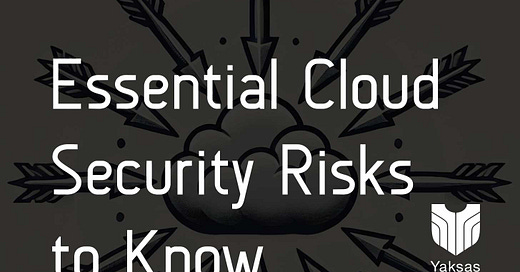Top Cloud Security Risks
In this article we outline the most critical security risks affecting cloud-based applications.
In this article we outline the most critical security risks affecting cloud-based applications. This list aims to raise awareness among developers, security professionals, and organizations about the common threats and vulnerabilities in cloud environments:
Poor Accountability and Data Ownership: This risk involves unclear data ownership when using cloud services, potentially leading to data mishandling or breaches. Ensuring clear contractual agreements about data management responsibilities between the organization and the cloud service provider is crucial.
Broken Access Control: Misconfigurations in access permissions can allow unauthorized access to data and resources. It's crucial to implement strict access controls and review them regularly.
Insecure Serverless Deployments: Functions in serverless architectures can be vulnerable if not properly managed. This includes ensuring secure deployment practices and monitoring function executions.
Misconfiguration and Inadequate Change Control: Cloud environments are prone to misconfigurations due to their complexity. Continuous monitoring and automated tools to manage configurations are recommended.
Insufficient Identity, Credential, and Access Management: Weak authentication mechanisms can lead to compromised accounts. Strong authentication methods, like multi-factor authentication, should be enforced.
Inadequate Logging and Monitoring: Without proper logging and monitoring, detecting breaches and malicious activities is challenging. Implement comprehensive logging and real-time monitoring systems.
Non-Production Environment Exposure: Development and testing environments often have less stringent security controls than production environments, making them more vulnerable to attacks. It's important to manage these environments carefully by enforcing appropriate security measures and regularly reviewing and updating them to prevent unauthorized access.
Non-compliance with Regulatory Requirements: Storing data across different geographies can expose organizations to various local and international compliance issues. Understanding and adhering to applicable regulations is vital to avoid legal penalties and reputational damage.
Inadequate User Identity Federation: Without proper identity federation mechanisms, there is a higher risk of unauthorized access across cloud platforms. It is important to implement robust identity solutions that integrate seamlessly across different services to ensure secure and consistent access controls.
Compromised User Privacy and Secondary Data Misuse: Data stored in the cloud can be repurposed or mishandled, leading to privacy violations. Organizations must enforce data usage policies and maintain transparency with users about how their data is used.
Which security risks have you found most challenging to address in your cloud environment, and how have you tackled them?
Join the discussion on Discord or WhatsApp (Yaksas Cybersecurity Infoshare).



